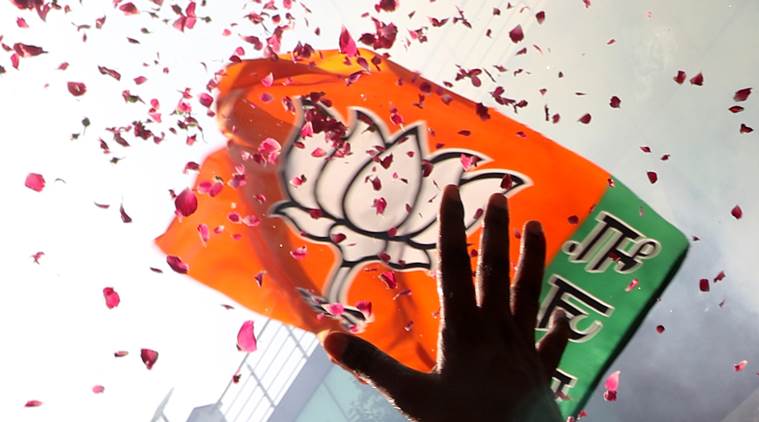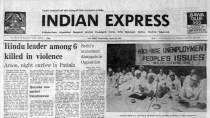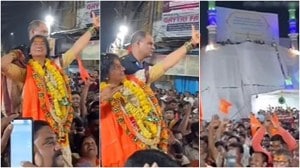- India
- International
How UP was conquered: BJP victory validates electoral mobilisation based on emotional appeals, patriotism
Flagship schemes and Modi’s personality did play their role, certainly. But the delinking of economic realities and political performance raises the thought that there is more to it than government performance and individual leadership.
 Celebrations at Bharatiya Janta Party state head office in Lucknow. (Express photo: Vishal Srivastav)
Celebrations at Bharatiya Janta Party state head office in Lucknow. (Express photo: Vishal Srivastav)
Contrary to nearly all expectations, the BJP has succeeded in retaining Uttar Pradesh, the key to holding its majority at the Centre. The Mahagathbandhan, poised to challenge the BJP on the basis of a formidable caste arithmetic, has failed to deliver. The BJP has won 77 per cent of the seats (62), against a measly 19 per cent for the alliance (15). The Congress, in yet another humiliating defeat in the heart of the Hindi belt, has lost one of the two seats it managed to salvage five years ago.
The BJP vote share increased from 42.3 per cent to 50.7 per cent, while the SP and BSP did worse collectively than they did on their own (in combination) in 2014. Five years ago, the SP and BSP respectively obtained 22.1 per cent and 19.6 per cent vote shares, for a combined total of 41.7 per cent. In 2019, they scored 38.4 per cent and 40.8 per cent respectively of the vote share in the seat they contested, that is 39.6 per cent of the aggregate vote share. This data reveals that the Samajwadi Party dragged down the alliance. With 10 seats, the BSP strike rate is at 26.3 per cent, against 13.5 per cent for the SP (for 5 seats won). Both Ajit Singh and his son, Jayant, lost their seats, in Muzaffarnagar and Baghpat, by small margins.
Despite the fanfare around Priyanka Gandhi’s supposed debut in politics, the Congress managed to lose 1.5 per cent vote share and registered its worst score ever in UP. Did it dent the Mahagathtbandan’s vote? Not as much as expected. Congress candidates finished second in only three seats: Fatehpur Sikri, Kanpur and Amethi. Besides, Congress candidates’ vote share exceeds the BJP victory margin in only 6 seats. It scored above 10 per cent of the vote share in only 15 seats.
The strategy of poaching MPs and MLAs from other parties did not pay off. For instance, Nasimuddin Siddiqui, Mayawati’s former Cabinet number two, received 2.3 per cent vote share. The strategy of engineering dissident factions did not pay off either. The PSP (Lohia), floated by Shivpal Singh Yadav a few months ago, crashed with less than half a per cent vote share, Shivpal scoring a meagre 8.6 per cent of the vote in Firozabad. BJP and Mahagathbandhan candidates received 88.5 per cent vote share on average. This was truly a bipolar contest.
What explains the verdict, then? One can point to at least three main reasons. The first one, obviously, is Modi’s popularity remaining intact despite the multitude of factors that should have gone against the BJP: Joblessness, a stagnant economy, rural distress, cow chaos, poor performance of the Yogi administration, individual anti-incumbency. None of these factors seemed to have affected the electoral appeal of the PM. It is too early to tell how much of a role the Balakot episode played, but one can surmise that even without it, the BJP would have remained ahead due to voters apparently not holding the PM responsible or accountable for their economic situation.

The second explanation, connected to the first, is that the variation in electoral behaviour between state and general elections is much greater than before. This is more striking in Chhattisgarh, Madhya Pradesh and Rajasthan, which the BJP swept after having lost the three state assembly elections not even six months ago. Increasingly, voters have no difficulty voting for different parties in different elections. In UP, this was reinforced by the fact that neither Akhilesh Yadav nor Mayawati had clear national ambitions, or at least a clear path towards a national role. The silver lining here for both regional parties is that their prospects could be better in the next state election.
The third explanation lies in the working of the alliance itself. The three parties of the Mahagathbandhan sought to defeat the BJP by combining their respective core support bases. Litres of ink have been consumed to describe how formidable a Jat-Yadav-Jatav-Muslim alliance would be against a heterogenous electorate, variously affected during five years of the Modi regime. In their near-exclusive focus on their own core bases, the alliance parties neglected to seek the support of other voters — BJP and Congress supporters as well as of non-aligned ones. The SP and BSP did succeed, against many odds, in coordinating their ground campaign, not only through mega-rallies but also through ground-level mobilisation. They did succeed in making their organisations work together despite their acrimonious history. But this effort was primarily aimed at ensuring that the vote transfers between the two parties’ bases would take place, rather than mobilising other segments of the electorate. As such, they did not offer much to other voters.
In 2017, the BJP came to power at the state level by campaigning on the promise to serve all groups not aligned with the SP or BSP. Their strategy targeted the 60 per cent or so of voters who did not belong to the regional parties’ core support groups: Yadavs, Jatavs or Muslims.
In 2019, the BJP repeated that strategy (going by the caste composition of their candidates), which found further validation from the fact that the alliance did not seem interested in wooing anyone other than their traditional supporters. The choice of focusing on caste while the BJP focused on general interest issues (including national security), trapped the alliance into a losing binary. The BJP did play the identity card in this election through its candidate selection, but it had more to offer to voters than raw caste-based calculations.
There is a fourth possible explanation, which remains under a question mark until data can be obtained. The rise of the BJP in UP has been accompanied by a vast expansion of Sangh Parivar-related organisations and by the spread of ideas nurtured by the Sangh Parivar at the ground level, including in rural constituencies. There is no denying that the BJP’s performance across the Hindi belt also has a strong cultural dimension, in the sense that the core ideology that animates the BJP and its parent organisation finds more acceptability. Sakshi Maharaj, the BJP’s saffron mascot from Unnao, won with 56 per cent of the vote share.
What are the larger implications for UP and for our understanding of electoral politics? For one, this victory validates a mode of electoral mobilisation based on emotional appeals, drawing on religious identities and patriotism. Flagship schemes and Modi’s personality did play their role, certainly. But the delinking of economic realities and political performance raises the thought that there is more to it than government performance and individual leadership.
This article first appeared in the print edition on May 25, 2019 under the title ‘How UP was conquered’. The writer is assistant professor of political science, Ashoka University, and co-director of the Trivedi Centre for Political Data. Views are personal
40 Years Ago
EXPRESS OPINION
More Explained
Apr 18: Latest News
- 01
- 02
- 03
- 04
- 05









































